Cursive Handwriting Practice Sheets: Free pdfs (SOR-Aligned)
This post may contain affiliate links. As an Amazon affiliate, we earn from qualifying purchases. See our disclosure policy.
Get 11 free cursive handwriting sheets that are Science of Reading Aligned for targeted cursive AND phonics practice. Read all about the importance and benefits of explicit handwriting instruction, including tips for teaching cursive writing.
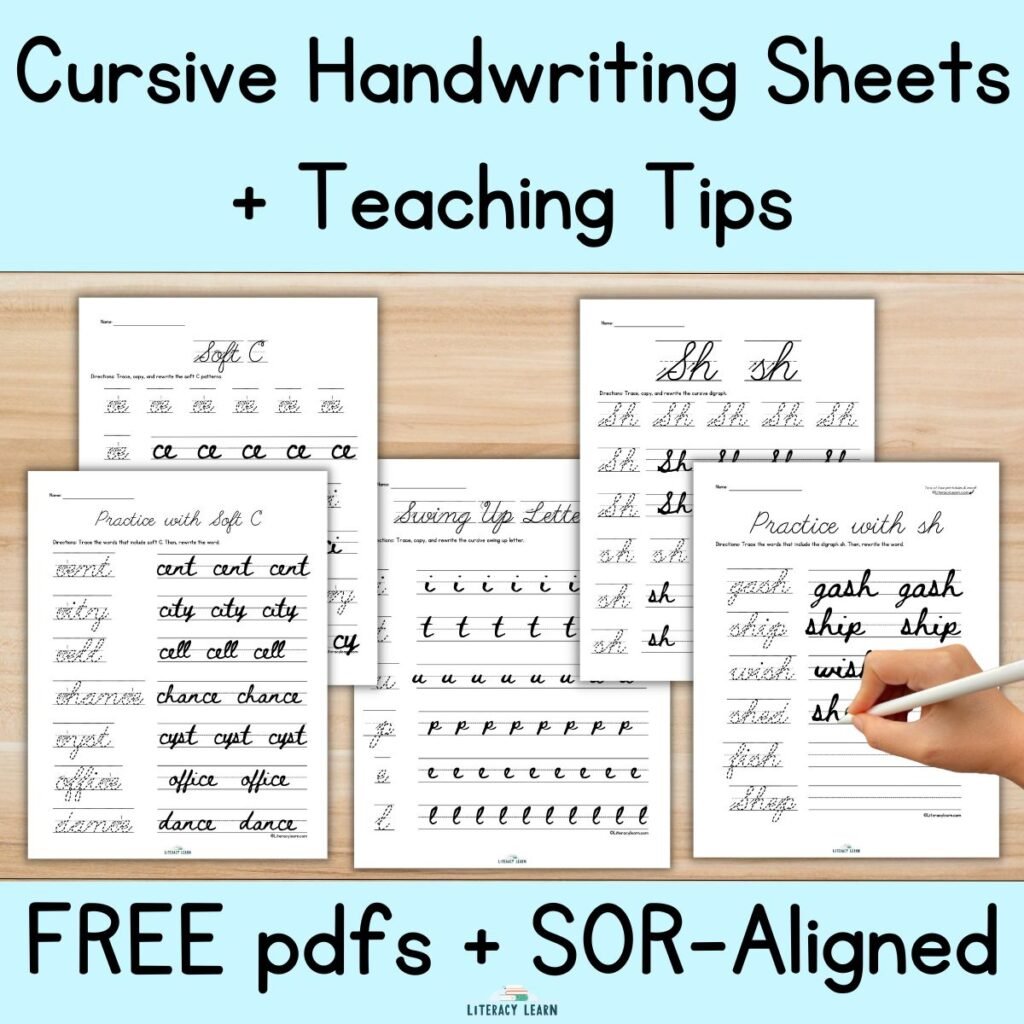
Why Teach Handwriting?
Current researchers have found that the human brain has many interconnected pathways related to literacy. That’s why current best practice is to use strategies to promote orthographic mapping – it helps build those important connections between letters and sounds.
But did you know that handwriting is a pathway too? Multiple studies have shown that practicing letter formation helps link the letters to speech sounds. But this connection doesn’t happen when typing. Fascinating, right!?
This is why research shows that when students learn explicit letter formation, they also become stronger readers, spellers, and writers. The connections between the pathways strengthen a child’s overall literacy skills.
Based on the science, most educators today would agree that handwriting instruction is extremely important. Many would also say that manuscript print should be taught first because the books kids will encounter in their early school careers are all written in manuscript. So it only makes sense!
But then that naturally raises the question:
👉 Do we need to spend time instructional time teaching cursive, or is manuscript enough?
Right now, there isn’t enough research to say if teaching cursive is a necessity. But what experts agree on, and what research supports, is that sounds and spellings should be taught along with letter writing.
Whether it’s manuscript or cursive, at least one script should be taught using a structured and explicit approach. In this post, we’re going to focus on cursive writing.
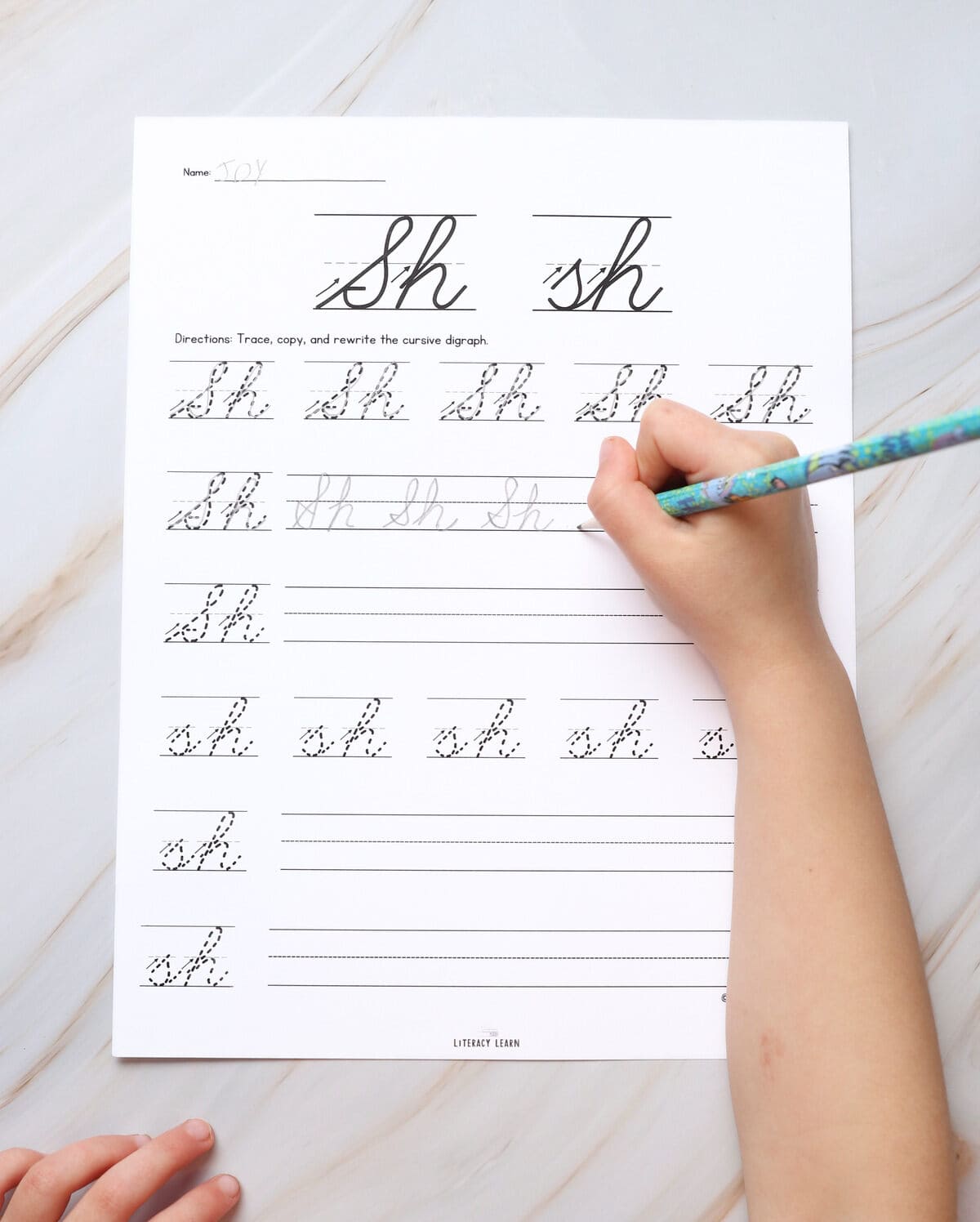
Benefits of Cursive Handwriting
There are definite benefits of cursive writing, especially for kids with dyslexia or dysgraphia. The International Dyslexia Association strongly advocates for teaching cursive writing, so we’ve listed out a few of the benefits below:
- It empowers people with the ability to read historical texts and expands their reading abilities in other areas of life. Imagine our children visiting Washington, D.C., walking up to the glass case that holds the Declaration of Independence, and not being able to read it.
- Cursive helps reduce some letter reversals. For example, b/d reverals may be minimized because each has a different stroke and movement pathway, even though they all begin on the baseline.
- Production is quicker because the letters flow together seamlessly (after explicit practice, of course). Students do not have to pick up their pencils between letters as they do with manuscript print.
- “When writing cursive, the word becomes a unit, rather than a series of separate strokes, and correct spelling is more likely to be retained” (Berninger, 2012).
- It’s a fresh start for students who may not have had explicit instruction in manuscript writing. So kids get the opportunity to learn correct letter formation. And most kids are super excited and motivated to learn cursive!
👉 Did you know? Research has shown that by middle school, most fluent writers have developed “a personalized mixture of cursive and manuscript” (Ball, 2016).
I have seen this firsthand with my older students, and I actually write like this myself!
Do We Teach Cursive or Not?
So even though there’s no conclusive research or evidence that we should be teaching cursive, I wanted to share where I stand on the issue based on experience and personal opinions…
👉🏽 In my experience as a teacher for over a decade, I believe it’s worthwhile to teach cursive. I want my students to be able to sign their names in cursive, and I feel it’s important that they can read all types of script wherever they encounter it.
👉🏽 I don’t think we teachers need to use a lot of instructional time to teach children cursive. This is because studies show that kids aren’t going to stick with writing in pure cursive. It’ll most likely wind up being a mixture of both cursive and manuscript.
👉🏽 I think cursive is important to teach to children with reading and writing challenges! My son is diagnosed with dysgraphia, and I’ve seen firsthand how his cursive writing is quicker and actually more legible.
👉🏽 I also believe that keyboarding is a very valuable tool, and kids need to learn this skill in the 21st century! I think this instruction can begin when kids are a bit older and only after handwriting has been explicitly taught. Typing instruction should never be a replacement for handwriting instruction.
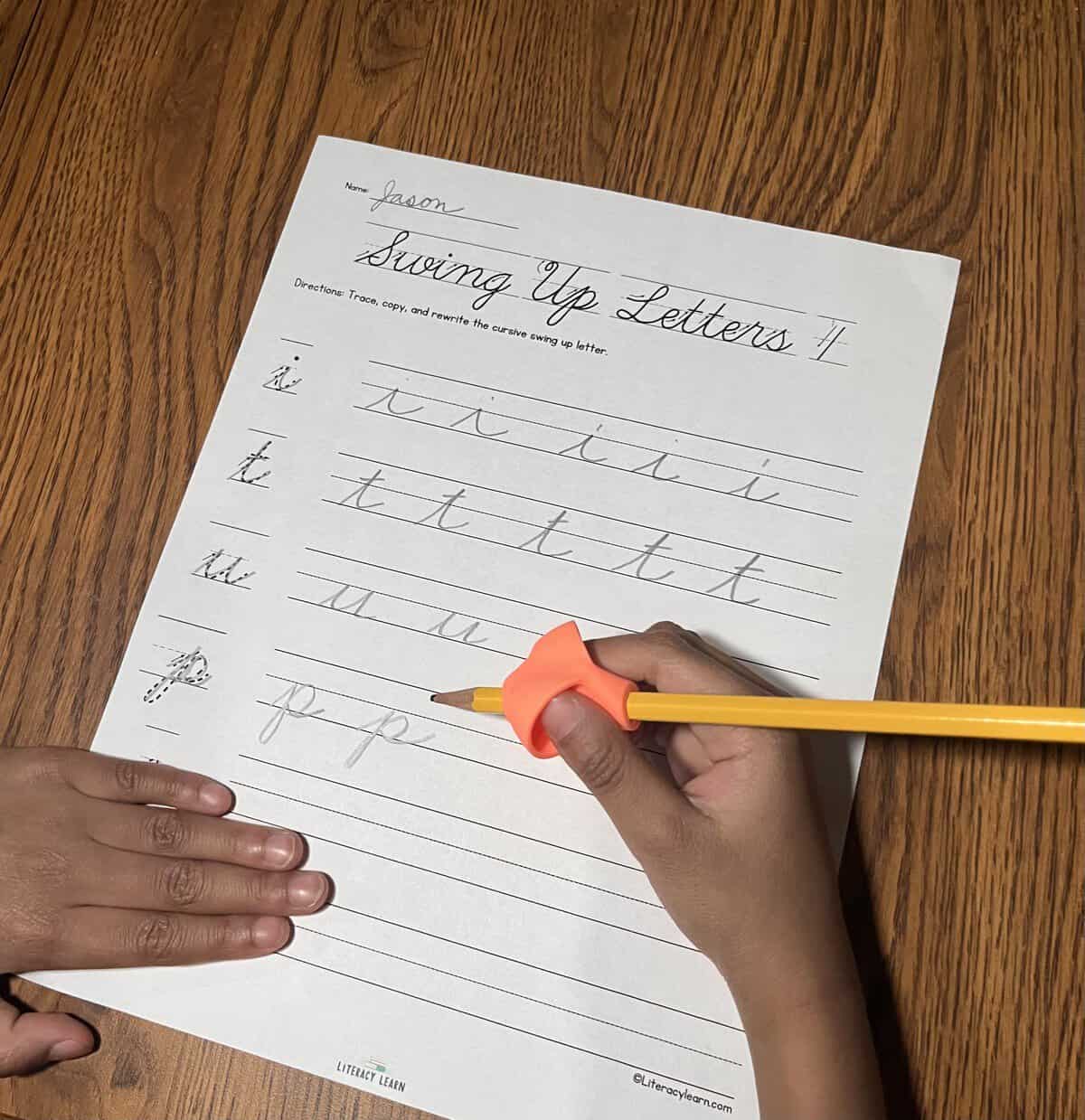
SOR-Aligned Cursive Worksheets
So if you decide to teach cursive to your child or your students, we’re here to help!
Keeping in mind everything that was mentioned above, this resource doesn’t just have kids practicing cursive letter formation in isolation. Instead, these cursive worksheets are designed to help kids learn cursive in connection with phonics and spelling skills.
The worksheets promote ligaturing (connecting letters) in a way that reinforces their knowledge of graphemes.
For example, the worksheet for the letter Q has QU together. Why? Because the spelling rule is “Never a Q without a U.” Other worksheets are specific to digraphs, like sh and ch, since so many words include these graphemes.
We’ve created 11 free worksheets for cursive writing practice. Included are:
- Swing Up Letters (3)
- Overstroke Letters (2)
- Digraph Sh (2)
- Soft C (2)
- Soft G (2)
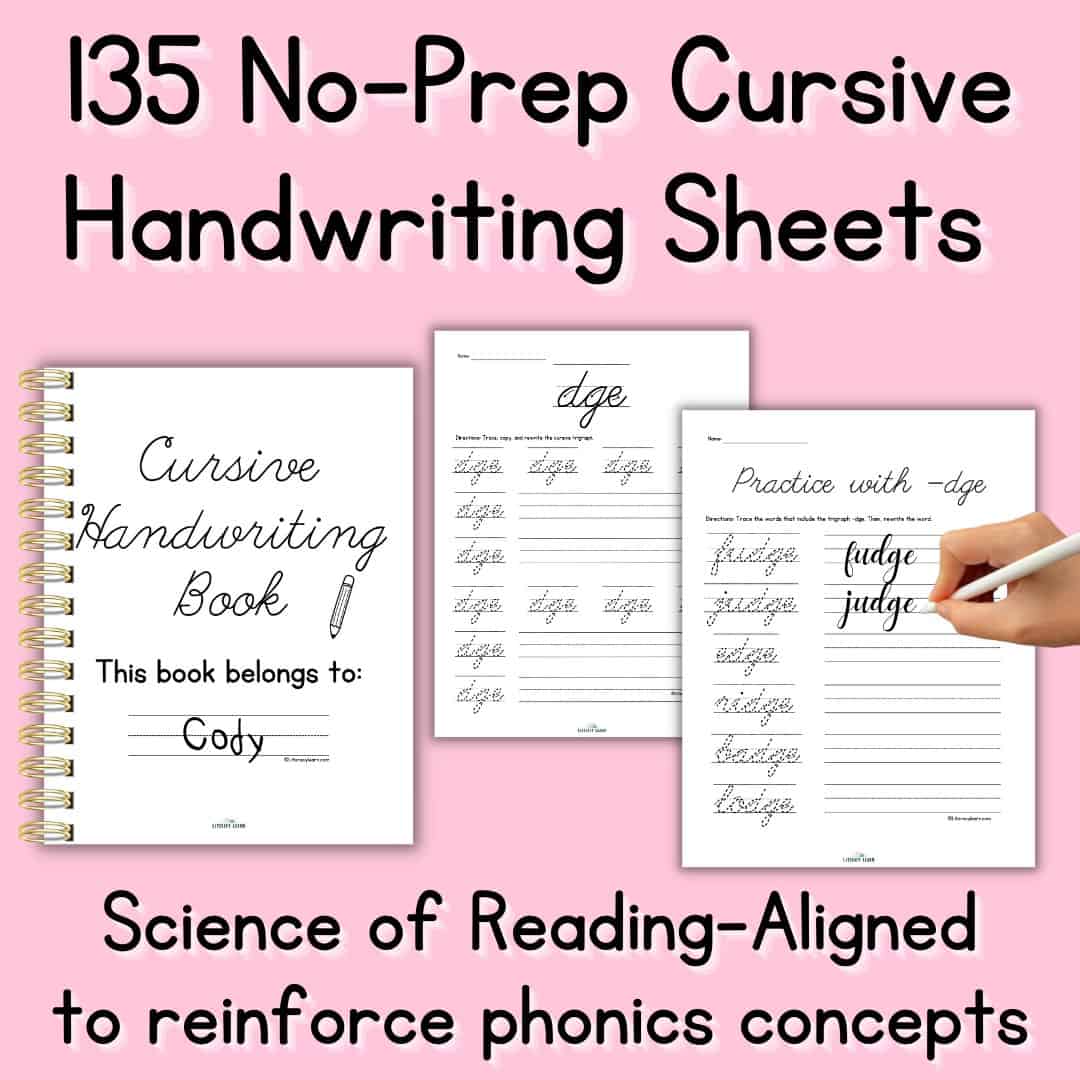
📝 We highly recommend grabbing our extended Cursive Handwriting resource that includes 135 no-prep pages. It’s really all you’ll need to teach and practice cursive handwriting while reinforcing phonics concepts!
Tips for Teaching Cursive
When using these worksheets, teach your students to use Simultaneous Oral Spelling (SOS). This is a procedure where students say the letter names aloud while forming the letters.
This allows children to link sounds with their letters as they write, and it’s the perfect example of multisensory practice!
You should also teach cursive letters in groups according to their movement pathways. All cursive letters start on the baseline, but we can categorize them into two main types of letters: Swing Up Letters and Overstrokes Letters.
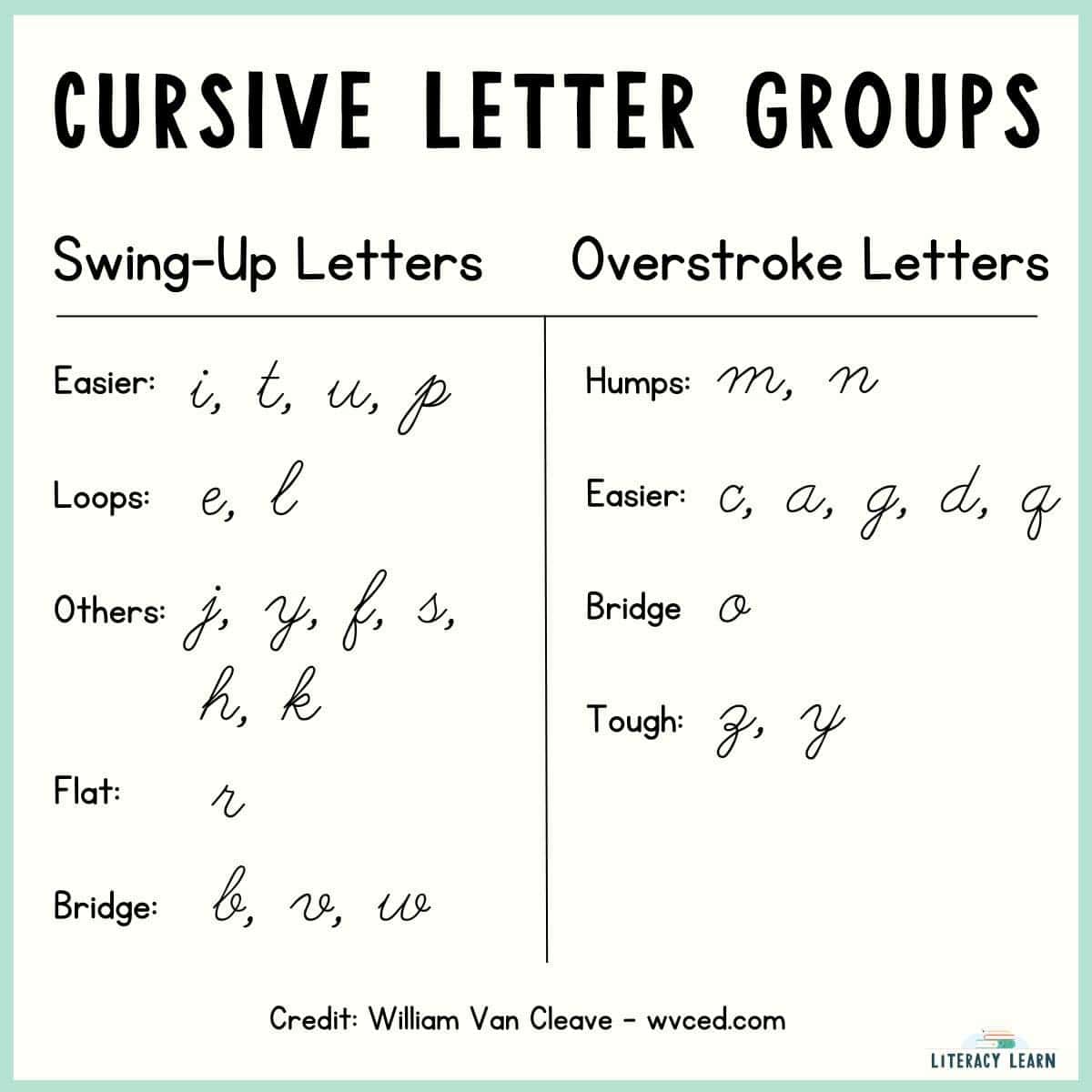
William Van Cleave suggests teaching these groups of letters in this order:
Swing Up Letters
- Easiest (i, t, u, p)
- Loops (e, l)
- Others (j, y, f, s, h, k)
- Flat (r)
- Bridge (b, v, w)
Overstrokes
- Humps (m, n)
- Easier (c, a, g, d, q)
- Bridge (o)
- Difficult (z, x)
Van Cleave also addressed other Best Practice Cursive Handwriting Tips:
- Body: Kids are seated in a chair with a back for good posture. Their feet are flat on the floor. Arms and elbows are comfortably resting on the table or desk.
- Paper: The paper is tilted at a 45-degree angle. If left-handed, the paper is tilted to the left. If right-handed, the paper is tilted to the right.
- Pencil Grip: A good pencil grip is key! The pencil is placed with the thumb and pointer finger gripping it, and the middle finger is beneath it acting as a bridge to hold the pencil up. The pencil is laying flat on the soft skin between the thumb and index finger. If students struggle with this, a great tool is this pencil grip. If your students need more targeted help, grab our 7 free pencil control worksheets.
Conclusion
Remember, whether you decide to teach cursive handwriting or not, the most important thing is that we teach children letter formation using a structured approach and explicit movement pathways.
This is what research supports as a key link within the brain that helps create better readers and writers.
What to learn more about brain science? Watch this webinar by cognitive scientist Stanislas Dehaene. He talks about the connection between speech, meaning, and letterforms in the human brain. It’s fascinating!
References:
- Berninger, V.W. (May-June 2012). Strengthening the Mind’s Eye: The Case for Continued Handwriting Instruction in the 21st Century. Principal, 28-31.
- James, K. H. (2017). The Importance of Handwriting Experience on the Development of the Literate Brain. Current Directions in Psychological Science, 26(6), 502 508. https://doi.org/10.1177/0963721417709821
- Wiley, R. W., & Rapp, B. (2021). The Effects of Handwriting Experience on Literacy Learning. Psychological Science, 32(7), 1086–1103. https://doi.org/10.1177/0956797621993111
🖨 Download & Print
DOWNLOAD TERMS: All of our resources and printables are designed for personal use only in homes and classrooms. Each teacher must download his or her own copy. Please do not save to a shared drive, reproduce our resources on the web, or make photocopies for anyone besides your own students. To share with others, please use the social share links provided or distribute the link to the blog post so others can download their own copies. Your support in this allows us to keep making free resources for everyone! Please see our Creative Credits page for information about the licensed clipart we use. If you have any questions or concerns regarding our terms, please email us. Thank you!
Do you teach cursive? We’d love to hear about your experience!
Please leave a comment below or tag us on Instagram @literacylearn!

